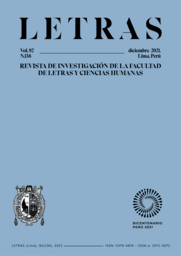Cosmopolitism and Identity in La casa de cartón by Martín Adán
Abstract
The style of La casa de cartón, by Martín Adán, has been catalogued as avant-garde due to the metaphorical use of language, the fragmented structure of the narrative and a descriptive rhythm that leads to its association with a “cinematographic” language. In this article I analyze the novel’s style as a function of representing the complex relationships between Latin American spaces and spaces perceived as cosmopolitan in the first half of the 20th Century, such as Europe and the United States. The problem of localization, as defined by Rosenberg, lead to negotiation between national and international spaces and places through the cinematographic montage experience. Adán draws on forms of modern experience, in particular perception influenced by the technology of cinema, to construct a language that allows for the “montage” of local and cosmopolitan spaces, and thus depicts a Lima neighbourhood as a node of cultural influence and identity construction. Adán’s Avant-garde writing not only shows a formal experimentation and a drive to seek new writing forms, but also, this type of writing, is a form of negotiation between cosmopolitan centres and national places in which experience, and the symbolic presentation of the world, is also a form of mediation a visual inscription.Downloads
Métricas alternativas
References
Adán, M. (2010). La casa de cartón. Lima: Peisa.
Alonso, M. (2020). Caleidoscopios poéticos em La casa de cartón, de Martín Adán. Revista Literatura em Debate, 14(26), 145-158.
http://revistas.fw.uri.br/index.php/literaturaemdebate/article/view/3462
Barthes, R. (1989). La cámara lúcida: nota sobre la fotografía. Paidós.
Benjamin, W. (1999). Walter Benjamin: selected writings, vol. 2, 1927-1934. Edición de Michael W. Jennings, Howard Eiland y Gary SmithBelknap Press.
Benjamin, W. (2004). Selected Writings. Cambridge: The Belknap Press of Harvard University Press.
Benjamin, W. (2015). La obra de arte en la época de su reproducibilidad técnica. Trad.: Luis Miguel Isava. El estilete.
Crary, J. (1990). Techniques of the Observer. On Vision and Modernity in the Nineteenth Century. MIT Press.
Eisenstein, S. y Gerould, D. (1974). Montage of Attraction: For “Enough Stupidity in Every Wiseman”. The Drama Review, 18(1) 77-85. https://doi.org/10.2307/1144865.
Grünfeld, M. (1989). Cosmopolitismo modernista y vanguardista: una identidad latinoamericana divergente. Revista Iberoamericana, 55, 147-147. https://doi.org/10.5195/REVIBEROAMER.1989.4545.
Jay, M. (2007). Ojos abatidos. La denigración de la visión en el pensamiento francés del siglo XX. Akal.
Kinsella, J. (1987). La creación de Barranco: Un estudio de La casa de cartón. Revista de Crítica Literaria Latinoamericana, 13(26), 87-96.
Kittler, F. (1999). Gramophone, Film, Typewriter. Stanford University Press.
Lauer, M. (2003). Musa mecánica. Máquinas y poesía en la vanguardia peruana. Instituto de Estudios Peruanos.
Outes-León, B. (2014). Poéticas de la materialidad en la vanguardia latinoamericana (1920-1930). (Tesis para obtener el Doctorado). Yale University, New Haven, Estados Unidos de América.
Pérez, I. (2013). Retrato del poeta adolescente: sujeto, identidad y narratividad en La casa de cartón de Martín Adán. Bulletin of Hispanic Studies, 90(2), 205-222. https://doi.org/10.3828/bhs.2013.15.
Quendler, C. (2012). The conceptual Integration of Intermediality: Literary and Cinematic Eye-Camera Narratives. En H. Schneider (Ed.), Blending and the Study of Narrative (199-228). Berlín: Walter de Gruyter.
Rosenberg, F. (2006) The Avant-Garde and Geopolitics in Latin America. University of Pittsburgh Press. https://digital.library.pitt.edu/islandora/object/pitt:31735062136753
Schwartz, J. (1993). Vanguardia y cosmopolitismo en la década del veinte. Oliverio Girondo y Oswald de Andrade. Beatriz Viterbo Editora.
Siskind, M. (2014). Cosmopolitan Desires. Global Modernity and World Literature in Latin America. Northwestern University Press.
Strajn, D. (2014). The Principle of Montage and Literature: Fragmented Subjectivity as the Subject-matter in Novel, Film and Digital Forms of Narration. Primerjalna književnost, 37(2), 5-19. http://www.dlib.si/details/URN:NBN:SI:DOC-DCPGWUQY
Valero, E. (2004). Martín Adán: de la urbe moderna a la ciudad ancestral. Philologia Hispanensis 18, 215-255. https://doi.org/10.12795/PH.2004.v18.i01.14
Verani, H. (1992 [1989]). La casa de cartón de Martín Adán y el relato vanguardista Hispanoamericano. En Actas del X Congreso de la Asociación Internacional de Hispanistas. Barcelona, 21-26 de agosto de 1989 (1077-1084). Promociones y Publicaciones Universitarias.
Verani, H. (1997 [1982]). Las vanguardias literarias en Hispanoamérica. En Lectura crítica de la vanguardia americana (Selección, prólogo y notas de Saúl Sosnowski) (9-66). Biblioteca Ayacucho.
Zegarra, C. (2008). Un país de beaver board: cinematografía y nación desechable en La casa de cartón de Martín Adán. Inti: Revista de literatura hispánica, 1(67-68), 81-96. https://digitalcommons.providence.edu/inti/vol1/iss67/6
Copyright (c) 2021 Letras (Lima)

This work is licensed under a Creative Commons Attribution 4.0 International License.
Este obra está bajo una licencia de Creative Commons Reconocimiento 4.0 Internacional



















